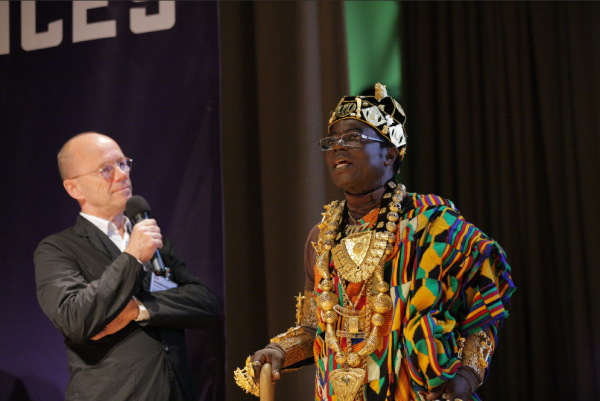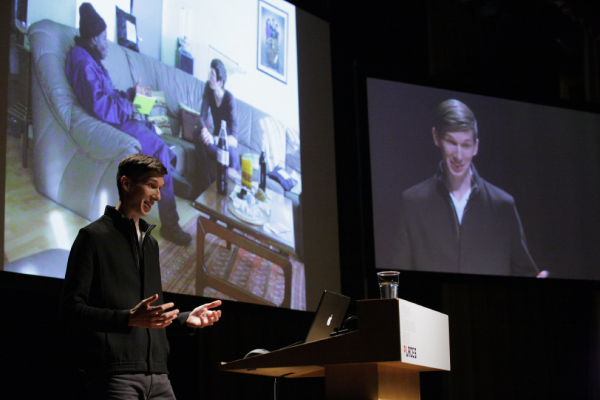Julian Zimmerman, the quietly spoken designer was somewhat overshadowed by Bansah who walked on stage in full ceremonial clothing to much applause. His second language is German, so Erik Spiekermann took on the role as royal translator.
We were introduced to the story of Bansah, who as a young man moved to Germany (Ludwigshafen) to learn his trade and absorb what he saw as German values of “duty, discipline, diligence, and ambition” (it should be noted his area of Ghana was once a Germany colony). He earned two German Master Craftsman certificates allowing him to set up his own car repair shop. In his younger days he regularly sung in discos to earn extra money, sending back any extra back to his family in Ghana, something he says, is expected of Africans. He made a life there; his own business, marrying a German and starting his own family.
In the early 1990s this all changed, when he received a fax from the Tribe elder, announcing that his grandfather, the king had died. At this point Bansah was third in line to the throne, behind his father and older brother. But under local custom, left-handers are not allowed to rule, so he instead he became king.
With that new role, his responsibilities exponentially grew – from just worrying about his family to being responsible for a kingdom of a quarter of a million people. He decided to remain in Germany and from there, but visit regularly. He started sending vans of medicine back to Ghana along with doctors, and funding for new projects to improve the welfare of his people. He has improved schools, bridges, access to water and repairing wheelchairs in his workshop for the large local disabled population.
However this meant him having to earn more money to help fund all these projects. Luckily, in Germany he has been able to use his celebrity status to help raise funds and awareness. He’s appeared on chat shows, opened supermarkets, started the kick off at football games and advertised chocolate. He’s released several albums of music, and had a popular single in Germany ‘Herz Aus Gold’ (Heart of Gold).
We come back to Julian Zimmermann who was fascinated by this man’s story and thought he could help. Looking at Bansah’s previous stationery, website, and image – it was frankly a mess –there was no coherent identity and it didn’t reflect the unique aspect of Bansah’s character and situation. Zimmermann proposed that he designed a new identity for King Bansah – something fit for a king.
It was apparent that Zimmerman had found a project of a lifetime, and threw himself into it, putting a lot of work into figuring out how to present this unusual celebrity. He regularly visited Bansah’s home, eating with his family, visited his village and trying to immerse himself into his people’s culture. He went to church, took part in a voodoo ceremony, and looked at the crafts – particularly the beautiful, bright geometric patterns common in Ghanian textile design.
Additionally it was important that the identity reflected both royalty and his role as entertainer, mixed in with the ‘exotic’ nature of an African king living in Germany.
He boiled down all these factors, and produced an identity that is luxurious, with elements of fun. Geometric textile patterns creep onto the page, each pictogram has an important meaning linking back to customs, beliefs, and his role as king. On Zimmerman’s website you can see the extent of his branding, from the expected such as stationery and website, to the more fun application such as the King’s own beer ‘Akosombo’ and the flag that sits on his ageing limo (with the tongue-in-cheek animal print reverse)Then Bansah stole the show again. His signature is something to behold, seemingly swirly chaos on first glance, but each part of the signature has its own story, from the rings representing his family to the horizontal line representing his life line.

King Bansah

Erik Spiekermann
Art Historian, Information Architect, Type Designer, Author (Berlin, San Francisco, London)
The design collaboration did not just stop there, they are now working on a new school together along with the involvement of an architect. A school that will cover art, design and crafts and a car repair workshop, of course (if you do feel generous, they are accepting donations.
King Bansah in his own quiet way, charmed and moved the Typo audience, and by the end there was a few damp eyes in the crowd. This is a story of a man who moved into a completely alien country and made something of himself, but has never forgotten the people he left behind.
Text: Ian Moore, Design Assembly











 Erik Spiekermann, King Bansah, photo © Gerhard Kassner
Erik Spiekermann, King Bansah, photo © Gerhard Kassner











Pingback: Fontblog | TYPO London 2011 im Rückblick